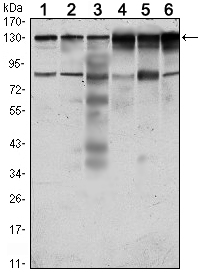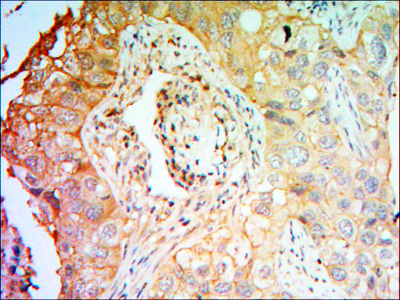CCK-4 Monoclonal Antibody
- Catalog No.:YM0098
- Applications:WB;IHC;IF;ELISA
- Reactivity:Human
- Target:
- CCK-4
- Gene Name:
- PTK7
- Protein Name:
- Inactive tyrosine-protein kinase 7
- Human Gene Id:
- 5754
- Human Swiss Prot No:
- Q13308
- Mouse Swiss Prot No:
- Q8BKG3
- Immunogen:
- Purified recombinant fragment of human CCK-4 expressed in E. Coli.
- Specificity:
- CCK-4 Monoclonal Antibody detects endogenous levels of CCK-4 protein.
- Formulation:
- Liquid in PBS containing 50% glycerol, 0.5% BSA and 0.02% sodium azide.
- Source:
- Monoclonal, Mouse
- Dilution:
- WB 1:500 - 1:2000. IHC 1:200 - 1:1000. ELISA: 1:10000.. IF 1:50-200
- Purification:
- Affinity purification
- Storage Stability:
- -15°C to -25°C/1 year(Do not lower than -25°C)
- Other Name:
- PTK7;CCK4;Inactive tyrosine-protein kinase 7;Colon carcinoma kinase 4;CCK-4;Protein-tyrosine kinase 7;Pseudo tyrosine kinase receptor 7;Tyrosine-protein kinase-like 7
- Molecular Weight(Da):
- 118kD
- References:
- 1. Oncogene. 1995 Nov 16;11(10):2179-84.
2. Cytogenet Cell Genet. 1997;76(1-2):43-4.
3. Biochem Biophys Res Commun. 2008 Jul 11;371(4):793-8.
- Background:
- This gene encodes a member of the receptor protein tyrosine kinase family of proteins that transduce extracellular signals across the cell membrane. The encoded protein lacks detectable catalytic tyrosine kinase activity, is involved in the Wnt signaling pathway and plays a role in multiple cellular processes including polarity and adhesion. Alternatively spliced transcript variants encoding multiple isoforms have been observed for this gene. [provided by RefSeq, Jul 2012],
- Function:
- function:May function as a cell adhesion molecule that acts as a regulator of planar cell polarity. Seems to lack tyrosine-protein kinase activity.,similarity:Belongs to the protein kinase superfamily. Tyr protein kinase family. Insulin receptor subfamily.,similarity:Contains 1 protein kinase domain.,similarity:Contains 7 Ig-like C2-type (immunoglobulin-like) domains.,tissue specificity:Highly expressed in lung, liver, pancreas, kidney, placenta and melanocytes. Weakly expressed in thyroid gland, ovary, brain, heart and skeletal muscle. Also expressed in erythroleukemia cells. But not expressed in colon.,
- Subcellular Location:
- Membrane ; Single-pass type I membrane protein . Cell junction . Colocalizes with MMP14 at cell junctions. Also localizes at the leading edge of migrating cells.
- Expression:
- Highly expressed in lung, liver, pancreas, kidney, placenta and melanocytes. Weakly expressed in thyroid gland, ovary, brain, heart and skeletal muscle. Also expressed in erythroleukemia cells. But not expressed in colon.
- June 19-2018
- WESTERN IMMUNOBLOTTING PROTOCOL
- June 19-2018
- IMMUNOHISTOCHEMISTRY-PARAFFIN PROTOCOL
- June 19-2018
- IMMUNOFLUORESCENCE PROTOCOL
- September 08-2020
- FLOW-CYTOMEYRT-PROTOCOL
- May 20-2022
- Cell-Based ELISA│解您多样本WB检测之困扰
- July 13-2018
- CELL-BASED-ELISA-PROTOCOL-FOR-ACETYL-PROTEIN
- July 13-2018
- CELL-BASED-ELISA-PROTOCOL-FOR-PHOSPHO-PROTEIN
- July 13-2018
- Antibody-FAQs
- Products Images

- Western Blot analysis using CCK-4 Monoclonal Antibody against HeLa (1), A431 (2), HCT116 (3), Caco2 (4), HepG2 (5) and MCF-7 (6) cell lysate.

- Immunohistochemistry analysis of paraffin-embedded lung cancer tissues with DAB staining using CCK-4 Monoclonal Antibody.



